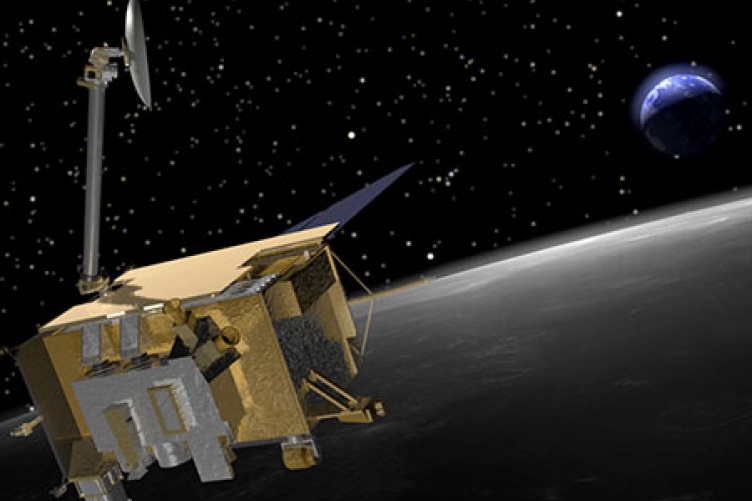
Artist's rendition of the Lunar Reconnaissance Orbiter at the moon. The CRaTER telescope is seen pointing out at the bottom right center of the LRO spacecraft. Illustration by Chris Meaney/NASA
You might say the sharp clicks produced by a Geiger counter are music to Marty Quinn’s ears.
Quinn, a professional musician and team member of the UNH-led Cosmic Ray Telescope for the Effects of Radiation (CRaTER) instrument on board NASA’s Lunar Reconnaissance Orbiter, has taken the mission’s raw data and “sonified” it into dulcet musical tones representative of the current radiation environment around the moon.
Although CRaTER is vastly more complex and sophisticated than a Geiger counter, it works essentially the same way—recording high-energy cosmic rays and solar energetic particles that stream through the heavens and bombard the moon, and CRaTER’s detectors.
Every time a speedy particle passes through one of six detectors there is an associated “click.” Using electronic gadgetry and hand-coded software, Quinn transformed the data into multi-instrumental scores that shift and drift with the ever-changing levels of intergalactic radiation that makes up space weather.
The radiation “notes” are represented from lower to higher counts by eight instruments—piano, kora, marimba, strings, steel drums, nylon stringed guitar, pizzicato strings, and banjo.
You can hear real-time space weather by going to CRaTER Radio anytime day or night. If the weather’s generally clear and calm the music will likewise be easy listening. But should the sun throw out an explosive coronal mass ejection or solar flare, the resulting music will get energized and edgy with minor keys and deeper tones.
|
Marty Quinn |
“Things are generally pretty calm ‘up there’,” notes Quinn, “and so the music stays pretty similar. But when there is a storm, the instruments will change and the scales will change. The sustained string sounds will go lower to represent the ‘weightiness’ of the radiation. In other words, if there are more particles hitting the detectors there’s more weight on them, and things that are heavier are usually lower in pitch. So the lower the pitches, the higher the radiation counts.”
A key goal of Quinn’s work is making scientific data more accessible and meaningful to people who are blind or visually impaired. To achieve this, the music of CRaTER data is accompanied by auditory explanations. To take a guided tour to the sonification, click here.
The Lunar Reconnaissance Orbiter was launched in 2009 as a preliminary step towards returning man to the moon. CRaTER characterizes the global lunar radiation environment and its biological impacts by measuring radiation from behind a "human tissue-equivalent" plastic. The mission’s Science Operations Center is housed in the Space Science Center at the UNH Institute for the Study of Earth, Oceans, and Space. CRaTER has made the most accurate and comprehensive measurements of radiation at the moon since the dawn of the space age.
For more on CRaTER, visit the website at http://crater.sr.unh.edu.
-
Written By:
Staff writer | Communications and Public Affairs

















































